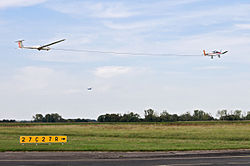Glider
A glider sailboat, or simply a glider, is a fixed-wing aerodyne (a heavier-than-air aircraft), with large wingspans, usually lacking engine. Its lift and translation forces come solely from the general aerodynamic result, just like those of other gliders such as paragliders and hang gliders. Sharing with them the practice of free flight, this type of aircraft is used in the sport of gliding (or volovelism), although it has also been used for other purposes, such as military or research.
Features
One feature is its high ratio of distance traveled to height lost (glide ratio). This characteristic makes this family of aircraft the most efficient way to fly. This is achieved by offering minimal resistance to a given lift force; that is why they have long and thin wings, and a narrow and aerodynamic fuselage. These properties facilitate the ascent thanks to ascending air currents (thermal or dynamic).
There are manned and unmanned or radio-controlled; life-size and scale model airplanes; there are flexible wings made of fabric (paragliding) or wings with rigid or semi-flexible structures (sailplane and hang glider). They are used for the practice of free flight.
Use of engines
Although many gliders do not have engines, there are some that occasionally use them, the so-called motor gliders or simply powered gliders. Today, high performance glider manufacturers often offer an engine as an option, along with a retractable propeller that can be used to provide lift in flight. Some are even able to take off on their own. On other models, the propeller cannot be retracted but the engine can be stopped after takeoff.
Flight systems
Flight is the procedure by which the glider "takes off", which is generally not possible under its own power. The two most frequently used methods are by aircraft towing or by winch.
Airplane Trailer
For towing, a single-engine light aircraft is normally used. The tow plane takes the glider to the desired location and height, where the glider pilot unhooks the tow rope. A weaker element is often added to the rope to ensure that sudden loads do not damage the towing aircraft.
During towing, the glider pilot must stay in one of two positions behind the tow plane: below or above the turbulence generated by the tow plane; the latter is the most common. A less used variant is the simultaneous towing of two gliders by a tow plane, using a shorter rope for the glider in the uppermost position.
Winch Trailer
In this case, a ground engine mounted on a mobile device normally pulls a long cable to which the glider is attached. The takeoff is very fast and with a high climbing angle; the uncoupling is done automatically, for safety, since the tow hook on the glider is different from the one on the airplane tow.
Contenido relacionado
K3b
Multiplexing
Pen drive



